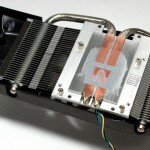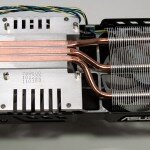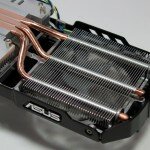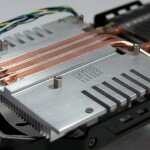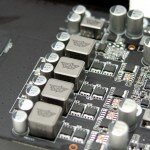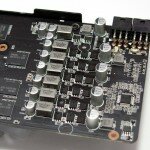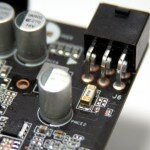What’s inside my ASUS graphics card?
Ever wondered what’s inside your ASUS graphics card? Well we decided to take apart and investigate the previously detailed ASUS GeForce GTX 550 Ti DirectCU and GeForce GTX 560 Ti DirectCU II graphics cards to find out.
Breaking them apart!
Four screws on the back whips off the DirectCU cooler. It’s not actually that heavy despite using two or three, fat copper heatpipes, as the aluminium fins that dissipate the heat make up much of its size. The heatpipes directly make contact with the GPU core too meaning the heat is transferred more efficiently. As you can see, the DirectCU II cooler is notably larger with three heatpipes on the GeForce GTX 560 Ti, as it has to cool a larger GPU core.
While both versions are up to 20% cooler than the reference design, DirectCU II with its dual-fan setup pushes 600% more air than the standard, single fan, meaning it can not only run quieter at normal clock speeds, but there’s more overhead for overclocking too.
The actual PCBs are upgraded as well – whereas the GeForce GTX 550 Ti uses 4+1 phase VRM the GeForce GTX 560 Ti is fitted with a 6+1 phase VRM. Both use the latest Super Alloy Power hardware – as signified by the ‘SAP’ logos on the electrical chokes. These are both 35ºC cooler while also giving 15% more power than the reference hardware, adding to that running cooler/greater overclocking overhead vibe. You really need both parts to get the absolute most of of your new GPU.
On each 6-pin power connector and 16x PCI-Express connector there’s a little white square with gold edges: this is the fuse protection that prevents serious damage to your graphics card from rouge power supplies or spikes from the wall socket (in some countries the local power is unfortunately not that reliable). The other addition is the GPU Guard – a metal bar that screwed into the edge of the PCB. This not only adds a touch of metal flair down one side, but it’s main job is to strengthen the PCB so it resists bending and flexing. Bending can sometimes break tiny solder joints during installation, killing the card, so obviously this is best avoided!
If you’re already running an ASUS DirectCU(II) card let us know your experiences, or if you have any questions please drop them in the comments below!


